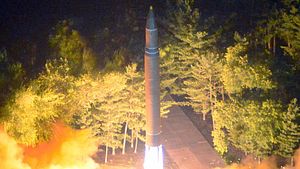On Sunday, U.S. President Donald J. Trump took to Twitter to tout the outcomes of his June 12 summit meeting with North Korean leader Kim Jong Un. There’s a lot to unpack in what he claimed over the course of the day, in the span of four tweets that Vipin Narang notes were more detailed together than the four operative clauses of the June 12 Singapore joint statement between Trump and Kim. For now, I’d like to focus on just one specific component of Trump’s claims.
Amid his other remarks on Sunday, Trump said the following: “No more nuclear testing or rockets flying all over the place, blew up launch sites. Hostages already back, hero remains coming home & much more!”
His claim on nuclear testing is correct insofar as North Korea, on April 20, announced that it would halt further nuclear tests because it had successfully attained the nuclear weapons designs that it sought over the course of six tests. (The North Korean announcement was unilateral and not framed as any sort of concession to the United States.)
On the “rockets flying,” Trump is using poetic license, but referring to Kim Jong Un’s self-imposed moratorium on flight-testing intercontinental-range ballistic missiles, which was also announced in April alongside the nuclear testing moratorium.
Trump continues to take credit for securing the release of Tony Kim, Kim Hak-song, Kim Dong-chul—the three American citizens that had been detained in North Korea. Finally, his reference to “hero remains” references the fourth operative clause of the Singapore joint statement, which sets out a path for the United States and North Korea to return to a practice that existed from the mid-1990s to 2005. The two sides committed “to recovering POW/MIA remains, including the immediate repatriation of those already identified.”
But in between these mostly factually correct claims, Trump added that North Korea has blown up “launch sites.” This is simply not true and is not a known concession anyway to come out of the Singapore summit. In the context of North Korea’s strategic forces, “launch sites” can be a bit of a misnomer. The country only uses static launch infrastructure—a launch pad and an accompanying gantry—for its space launch activities. (The Sohae Satellite Launching Station, for instance; we recently had a report from Chosun Ilbo indicating that North Korea had offered to dismantle its static missile engine test stand there, but that’s separate from the launch site.)
The rest of North Korea’s launch activities—including those associate with the entirety of its short-, medium-, intermediate-, and intercontinental-range ballistic missiles—use road mobile launchers. That would mean that even if North Korea did conduct some kind of ceremony to “disable” a previously used launch site, it would effectively be meaningless given that these kinds of road-mobile launchers are designed to enable launch from a variety of locations.
The claim about launch sites isn’t Trump’s first false statement in support of the outcome of the June 12 summit. Most egregiously, on his return from Singapore, Trump stated that “There is no longer a Nuclear Threat from North Korea” as a result of his summit with Kim—all this while North Korea makes no commitments to actually roll back any of its capabilities. Separately, on June 12, Trump also claimed that North Korea had ceased any nuclear “research” activities—a statement borne out by no evidence at the Singapore summit or its aftermath (and one that’d be virtually impossible to verify with current levels of access).
Trump’s propensity to exaggerate and even fabricate the outcomes of his June 12 summit meeting with Kim will raise public expectations. North Korea may or may not choose to offer up other symbolic confidence-building measures, but it is certainly still unwilling to disarm itself of its nuclear arsenal—what it’s taken to recently calling its “treasured sword.”

































